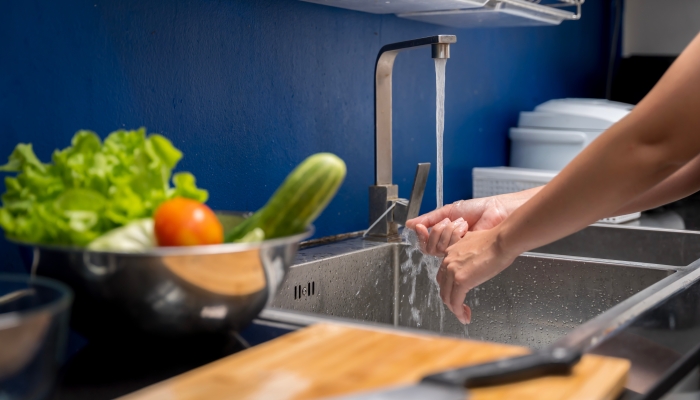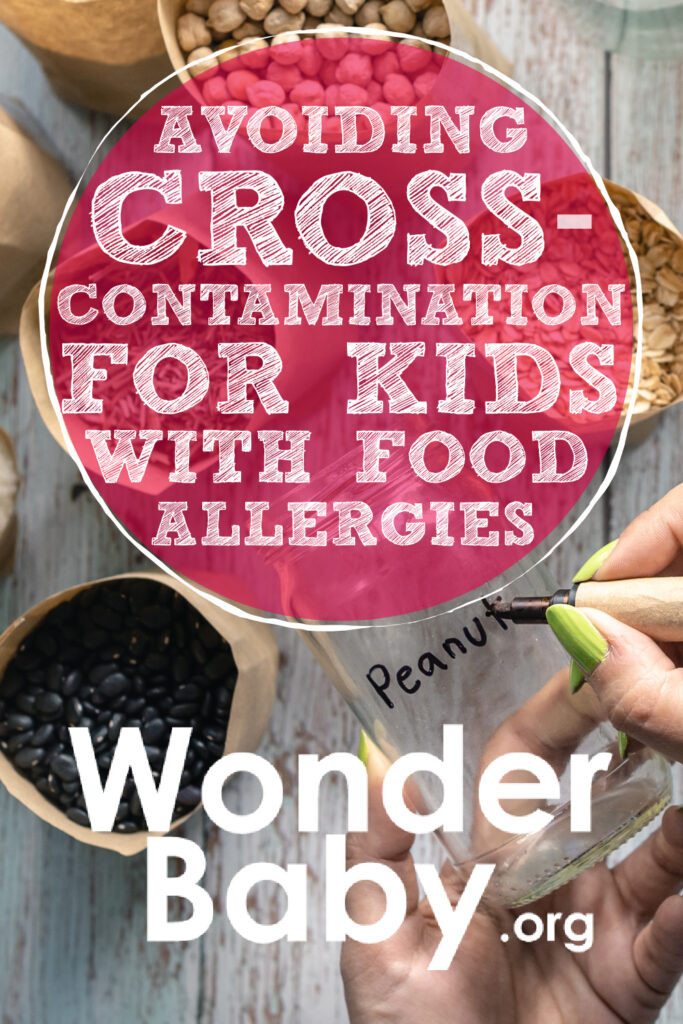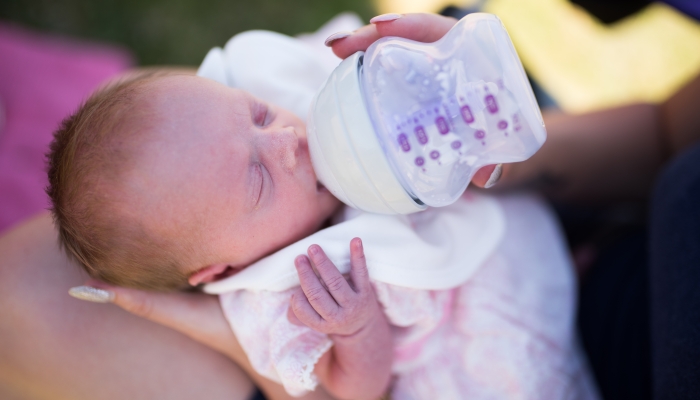Avoiding Cross-Contamination for Kids With Food Allergies

- Foods impacted by cross-contamination can be hazardous to individuals with food allergies.
- Cross-contact can occur in school, restaurant, and home settings.
- There are many ways to reduce the potential of cross-contaminating items.
- Good handwashing technique with liquid soap is the single best way to remove food proteins from hands after inadvertent exposure.
When I was first diagnosed with food allergies, one of the biggest adjustments I needed to make was preparing food while sharing a kitchen with food allergens. Mindful of the risk of cross-contamination, I was vigilant for ways to prevent cross-contact while I worked to prepare allergen-free food.
There was a big learning curve then, and it became even more significant later when my child was diagnosed with an anaphylactic tree nut and peanut allergy. Knowing that exposure to even trace amounts of my child’s allergens could cause an allergic reaction, I went on a mission to make our home as allergy-friendly as possible.
If you’re working to avoid cross-contamination for your child with food allergies, there are some ways to ease your adjustment to this new way of thinking and preparing food.
Understanding Food Allergy Cross-Contamination

If you spend time comparing notes with other parents of kids with food allergies, one of the main topics that will probably be discussed is the best way to prevent cross-contact and contamination of other foods.
But what does this term mean and is it really that much of a problem?
What is Cross-Contamination?
Though phrases like “cross-contact” and “cross-contamination” are often used interchangeably (as they are in this article), the experts at Food Allergy Research and Education (FARE) remind us that cross-contamination11. Avoiding Cross-Contact. FoodAllergy.org. https://www.foodallergy.org/resources/avoiding-cross-contact is “a common factor in the cause of foodborne illness . . . Proper cooking of the contaminated food in most cases will reduce or eliminate the chances of a foodborne illness.”
However, the term cross-contact refers to “when one food comes into contact with another food and their proteins mix. As a result, each food then contains small amounts of another food.” The experts at FARE also state that cooking does not reduce or eliminate the chances of having an allergic reaction for a susceptible person.
Though the terms are often used interchangeably, the concepts behind them refer to different reactions in the body and there are often misperceptions.
Is Cross-Contamination a Problem?
Cross-contamination, or cross-contact, is a serious concern for individuals with a food allergy.
A 2021 study entitled “Understanding Food-Related Allergic Reactions Through a US National Patient Registry”22. Fierstein, J. L., Brown, D., Gupta, R., & Bilaver, L.. Understanding Food-Related Allergic Reactions Through a US National Patient Registry. The Journal of Allergy and Clinical Immunology: In Practice. 2021;9(1). https://doi.org/10.1016/j.jaip.2020.08.011 by Fierstein and colleagues published in The Journal of Allergy and Clinical Immunology relates that “of the 3054 respondents who completed the most recent reaction survey, 9.9% of food allergen exposures were classified as intentional, 82.1% as unintentional, and 4.8% as medically related.”
Fierstein adds that “cross-contamination was the most commonly cited reason for unintentional exposure (children: 24.1%; adults 32.2%).”
In the context of food allergy cross-contamination, this scenario may commonly occur in a few different ways, such as:
- Using the same utensils to scoop out peanut butter and jelly from different containers. (This leaves tiny amounts of peanut allergen in the jelly and the jelly becomes unsafe for a peanut-allergic individual.)
- Cooking allergen-containing food and allergen-free food on the same surface. (For example, making grilled cheese for yourself in one pan and then using the same pan, without cleaning, to saute’ vegetables for a person with a cow’s milk allergy.)
- Allowing children who have handled products containing food allergens to touch other objects before washing their hands. The person with food allergies is then at high risk of experiencing an allergic reaction.
- In a childcare, daycare center, or school, cross-contact could look like using the same sponge to wipe off tables, tray tables, or food trays, which could potentially transfer allergens between children and pose a greater risk to a child’s eating surface.
- In the food service industry, cross-contact may look like cooking fried foods in the same fryer that makes non-allergenic and allergenic foods. (For example, this practice could mean frying mozzarella sticks or chicken tenders in the same oil as fries, which would make the fries unsafe for individuals with a milk protein allergy or a food allergy to wheat.)
- Food manufacturers may process seed products, such as sunflower seeds, on equipment that first processed tree nuts, without cleaning the lines from the tree nut products first.
Food allergen contamination of an otherwise safe product puts individuals with food allergies at high risk of a food allergy emergency33. Allergy and Anaphylaxis Emergency Plan. American Academy of Pediatrics. 2019. https://downloads.aap.org/HC/AAP_Allergy_and_Anaphylaxis_Emergency_Plan.pdf or anaphylaxis44. Anaphylaxis: Causes, Symptoms & Treatment. ACAAI Public Website. 2018. https://acaai.org/allergies/symptoms/anaphylaxis.
The Impact of Cross-Contamination on Kids with Food Allergies
Maintaining constant vigilance to avoid an allergic reaction through contact55. Tan, B. M., Sher, M. R., Good, R. A., & Bahna, S. L.. Severe food allergies by skin contact. Annals of Allergy, Asthma & Immunology. 2001;86(5), 583–586. https://doi.org/10.1016/s1081-1206(10)62908-0, ingestion66. Abrams, E. M., & Sicherer, S. H.. Diagnosis and management of food allergy. Canadian Medical Association Journal. 2016;188(15), 1087–1093. https://doi.org/10.1503/cmaj.160124, or inhalation77. Ramirez, D. A., & Bahna, S. L.. Food hypersensitivity by inhalation: Clinical and Molecular Allergy. BioMed Central. 2009. https://clinicalmolecularallergy.biomedcentral.com/articles/10.1186/1476-7961-7-4 can take a mental toll on kids of all ages.
A 2014 study by Shanahan et al titled “Are Children and and Adolescents with Food Allergies at Increased Risk for Psychopathology?”88. Shanahan, L., Zucker, N., Copeland, W. E., Costello, E. J., & Angold, A.. Are children and adolescents with food allergies at increased risk for psychopathology? Journal of Psychosomatic Research. 2014;77(6), 468–473. https://doi.org/10.1016/j.jpsychores.2014.10.005 published in the Journal of Psychosomatic Research reported, “On average, adolescents with food allergies . . . increased in their symptoms of depression and generalized anxiety over time.”
Heightened awareness of foods is an unfortunate by-product of living with dietary restrictions.
Though constant vigilance is wearing, studies, like the 2011 study titled “Living with food allergy: Allergy avoidance,”99. Kim, J. S., & Sicherer, S. H.. Living with Food Allergy: Allergen Avoidance. Pediatric Clinics of North America. 2011;58(2), 459–470. https://doi.org/10.1016/j.pcl.2011.02.007 by Kim and Sicherer and published in Pediatric Clinics of North America remind us that strict avoidance is the only known way to successfully manage food allergies.
Fortunately, many families are able to work to find a liveable balance between being appropriately watchful and regularly participating in special events with other children.
Identifying Potential Sources of Cross-Contamination

When you consider that cross-contact is as simple as the mixing of food proteins—and that the contamination of other foods can happen on a microscopic level—it’s hard not to be anxious or fearful of eating food accidentally compromised by other, well-meaning individuals.
Here are some ways food allergens may contaminate food preparation in different locations:
Cross-Contamination in the Home
As much as possible, keeping your kitchen an allergen-free zone can help reduce the likelihood that a meal prepared in your home will be affected by cross-contact. Cutting boards, sponges, eating utensils, and drying towels can all harbor food proteins that can cause an allergic reaction.
Particularly when having play dates at homes where the host and their children do not have food allergies, extra care must be taken to protect the child with food allergies from unintended exposure through shared play items.
Cross-Contamination in Schools
Managing cross-contact situations in school is a unique challenge. Unintentional exposure in the classroom can occur through shared play items, craft supplies, or school supplies. A cafeteria has widespread exposure to the top nine allergens and more. Milk proteins may be spread easily when a carton is overturned, not to mention the crumbs left behind by different foods or food products.
Unintentional cross-contact occurs through poor hand-washing skills when students handle communal items while bearing traces of peanut protein or other allergens.
Cross-Contamination in Restaurants
Depending on the type of restaurant, there are a variety of practices that can impact the ability to safely enjoy a meal. Communal dining options, like salad bars or buffets, can feel like a minefield—the serving and eating utensils may travel from one allergen-containing dish to another.
Further, inside the kitchen, it’s almost impossible to know if the cooking surfaces used to prepare meals are properly cleaned from allergenic food protein before making your meal, or if everything used to prepare food is cleaned at the end of the day.
Discuss your concerns about cross-contamination with your server throughout your meal to make informed choices about your dining options.
Practical Steps to Avoid Cross-Contamination

Knowing that cross-contact can sometimes happen without thinking, what are ways that parents and kids can work to minimize risk while still enjoying life?
Best Practices at Home
The experts at Kids with Food Allergies1010. Avoiding Cross-Contact In Your Kitchen. Kids With Food Allergies. 2014. https://kidswithfoodallergies.org/living-with-food-allergies/choosing-safe-foods/prevent-allergic-reactions-in-your-kitchen have several excellent suggestions for preventing cross-contact and safely storing and preparing food for family members with food allergies.
Among other ideas, consider:
- Label all foods “safe” or “not safe” through the use of color-coded stickers.
- Avoid storing similar products next to each other. (For instance, if your child has a tree nut or peanut allergy, avoid storing the Wowbutter next to the nut butters.)
- Designate specific cups, bottles, or sippy cups that are only for use by the child with food allergies and label them clearly with that child’s name. Drinkware should not be shared between children. This strategy is particularly helpful if the child in question has a cow’s milk allergy.
- Removing nuts (or your child’s allergens) from the home, or limiting their consumption only to the kitchen area.
- If you share your home with your child’s allergens, wash cookware, eating utensils, and prep surfaces in hot soapy water before preparing food for that child.
- Rinse off items that have been used to prepare foods with allergens before loading them in the dishwasher.
Preventing exposure to food allergens in the home, like peanut protein, can be done successfully through thoughtful planning and careful food preparation.
Strategies for Schools
Discussion with your child’s teacher about their allergens, including symptoms of allergic reaction after exposure, may help them grasp the impact that one food can have on a susceptible individual.
Think creatively together about ways to manage exposure to tree nuts and other major allergens in the classroom, while encouraging the use of good handwashing or hand sanitizing gels.
School officials may enact a variety of methods, including a designated eating area, to keep your student safe while dining at school.
Eating Out Safely
Clear communication with serving staff is imperative to a safe, successful dining experience.
Depending on where we’re eating, I’ve used any of the following strategies with success:
Research before leaving.
If at all possible, research the menu of a proposed restaurant before leaving to learn if they can accommodate your specific food allergy. I’ve been burned a few times when I assumed that a wheat or tree nut allergy could be safely managed, only to learn that the facility wasn’t able to meet our requests. Not the memories you want on a family vacation.
Alert the staff.
Upon meeting our server, I notify them that our party has individuals with severe food allergies and ask if that individual is willing to work with us to find safe meal options. Usually, the server will say yes and bring the manager over to meet us and discuss their food preparation practices, as well as help to identify safe meal options or modifications.
Ask about environmental surfaces.
Ice cream parlors can be very tricky places for people with food allergies—the risk of cross-contamination is very high, and it may be difficult, if not impossible, to eliminate all food allergens from a utensil used to scoop from different cartons of ice cream.
Even a new spoon can unwittingly scoop up ice cream contaminated from prior use. At times, the staff at ice cream parlors will open a brand new container of ice cream and use a completely fresh utensil, but this kindness is rare. Again, talk with your server to identify potential safe choices and their practices (if any) to contain allergens.
Avoid sharing.
While sharing is a good practice to encourage, a child with food allergies should not give their food to others, or allow others to share food with them.
“When in doubt, throw it out.”
One of my more vivid near-miss memories was when my child ordered a known safe treat from an established location that we have successfully dined at in the past.
From the backseat, my child announced “Hey Mom, this treat doesn’t look like it usually does—I think there’s nut stuff mixed in.” We went back around the building, explained the situation, and asked that they dispose of my child’s treat and make a fresh one.
Rarely do I insist that food be made over again, but if there are any doubts about the safety of a product your food-allergic child is going to consume, the possible risks of eating it far outweigh any short-term benefits.
Because most food allergy emergencies and allergic reactions are the result of unintentional exposures, it’s imperative that life-saving emergency medications are brought along every time your food-allergic child dines away from home.
Cleaning and Cross-Contamination

You may be wondering how handwashing fits in with preventing food cross-contamination, as well the best ways to clean surfaces used to prepare food once they’ve encountered other food allergens like peanut and tree nuts.
Which method for cleaning hands is best? A 2004 study by Perry and colleagues titled “Distribution of Peanut Allergen in the Environment”1111. Perry, T. T., Conover-Walker, M. K., Pomés, A., Chapman, M. D., & Wood, R. A.. Distribution of Peanut Allergen in the environment. Journal of Allergy and Clinical Immunology. 2004;113(5), 973–976. https://doi.org/10.1016/j.jaci.2004.02.035 and published in the Journal of Allergy and Clinical Immunology tested the efficacy of removing peanut protein by rubbing peanut butter on the hands of the participants, using a cleansing method, and evaluating the result.
Here were their findings:
| Method and Product | Result |
| Hand washing with liquid soap | Undetectable |
| Hand washing with plain water | 25%; less effective |
| Hand sanitizing gels/alcohol-based sanitizer | 50%; least effective |
The same study also evaluated means of removing peanut protein from surfaces by a variety of methods. Here were the results:
| Method and Product | Result |
| Alcohol-based hand wipes/commercial wipes | Undetectable |
| Commercial cleaning agents/commercial cleaners (e.g. bleach) | Undetectable |
| Dishwashing liquid | 33%; less effective |
| Disposable methods (e.g. paper towel) | Ineffective; does not remove proteins |
There’s no doubt that properly cleaned hands and surfaces are vital in preventing cross-contact. Take the time to think through all the ways your child may encounter inadvertent allergen exposure through cross-contact and work with them to develop practical ways to limit risk.
References
- Avoiding Cross-Contact. FoodAllergy.org. (n.d.). https://www.foodallergy.org/resources/avoiding-cross-contact
- Fierstein, J. L., Brown, D., Gupta, R., & Bilaver, L. (2021). Understanding Food-Related Allergic Reactions Through a US National Patient Registry. The Journal of Allergy and Clinical Immunology: In Practice, 9(1). https://doi.org/10.1016/j.jaip.2020.08.011
- Allergy and Anaphylaxis Emergency Plan. American Academy of Pediatrics. (2019, March). https://downloads.aap.org/HC/AAP_Allergy_and_Anaphylaxis_Emergency_Plan.pdf
- Anaphylaxis: Causes, Symptoms & Treatment. ACAAI Public Website. (2018, January 29). https://acaai.org/allergies/symptoms/anaphylaxis
- Tan, B. M., Sher, M. R., Good, R. A., & Bahna, S. L. (2001). Severe food allergies by skin contact. Annals of Allergy, Asthma & Immunology, 86(5), 583–586. https://doi.org/10.1016/s1081-1206(10)62908-0
- Abrams, E. M., & Sicherer, S. H. (2016). Diagnosis and management of food allergy. Canadian Medical Association Journal, 188(15), 1087–1093. https://doi.org/10.1503/cmaj.160124
- Ramirez, D. A., & Bahna, S. L. (2009, February 20). Food hypersensitivity by inhalation: Clinical and Molecular Allergy. BioMed Central. https://clinicalmolecularallergy.biomedcentral.com/articles/10.1186/1476-7961-7-4#citeas
- Shanahan, L., Zucker, N., Copeland, W. E., Costello, E. J., & Angold, A. (2014). Are children and adolescents with food allergies at increased risk for psychopathology? Journal of Psychosomatic Research, 77(6), 468–473. https://doi.org/10.1016/j.jpsychores.2014.10.005
- Kim, J. S., & Sicherer, S. H. (2011). Living with Food Allergy: Allergen Avoidance. Pediatric Clinics of North America, 58(2), 459–470. https://doi.org/10.1016/j.pcl.2011.02.007
- Avoiding Cross-Contact In Your Kitchen. Kids With Food Allergies. (2014, July). https://kidswithfoodallergies.org/living-with-food-allergies/choosing-safe-foods/prevent-allergic-reactions-in-your-kitchen
- Perry, T. T., Conover-Walker, M. K., Pomés, A., Chapman, M. D., & Wood, R. A. (2004). Distribution of Peanut Allergen in the environment. Journal of Allergy and Clinical Immunology, 113(5), 973–976. https://doi.org/10.1016/j.jaci.2004.02.035

The information WonderBaby provides is not intended to be, and does not constitute, medical or other health advice or diagnosis and should not be used as such. Always consult with a qualified medical professional about your specific circumstances.
Related Posts

Feeding and Eating, Special Needs
Feeding Therapy Approaches for Infants with Special Needs
Many children with special needs have feeding difficulties. Working with a speech therapist, being patient, and experimenting with textures can help.

Feeding and Eating
Unexpected Foods That Cause Allergen Cross-Reactivity
A variety of unexpected foods and environmental substances can trigger an allergic reaction through cross-reactivity to food proteins.

Feeding and Eating
Easing Anxiety for Families Facing Food Allergies
Ongoing physical preparations and speaking openly about anxiety can ease the transition from diagnosis to living well with a food allergy.